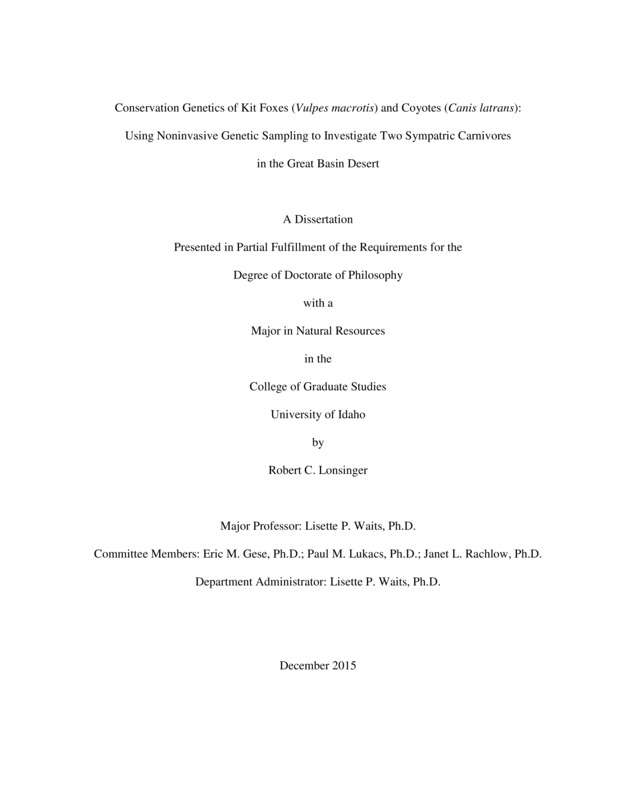Conservation Genetics of Kit Foxes (Vulpes macrotis) and Coyotes (Canis latrans): Using Noninvasive Genetic Sampling to Investigate Two Sympatric Carnivores
Lonsinger, Robert C.. (2015). Conservation Genetics of Kit Foxes (Vulpes macrotis) and Coyotes (Canis latrans): Using Noninvasive Genetic Sampling to Investigate Two Sympatric Carnivores. Theses and Dissertations Collection, University of Idaho Library Digital Collections. https://www.lib.uidaho.edu/digital/etd/items/lonsinger_idaho_0089e_10752.html
- Title:
- Conservation Genetics of Kit Foxes (Vulpes macrotis) and Coyotes (Canis latrans): Using Noninvasive Genetic Sampling to Investigate Two Sympatric Carnivores
- Author:
- Lonsinger, Robert C.
- Date:
- 2015
- Embargo Remove Date:
- 2017-01-19
- Keywords:
- abundance estimation canid capture-recapture intraguild predation noninvasive genetic sampling occupancy
- Program:
- Natural Resources
- Subject Category:
- Wildlife management; Ecology; Genetics
- Abstract:
-
Resource managers worldwide are challenged to protect sensitive species. The status of many species remains ambiguous, in part due to the difficulty in developing cost-efficient monitoring programs. We used noninvasive genetic sampling (NGS) to investigate two sympatric carnivores in the Great Basin Desert: kit foxes (Vulpes macrotis) and coyotes (Canis latrans). We developed a conceptual model to optimize NGS design for capture-recapture analyses. We compared statistical classification approaches to field identification (ID) of carnivore scats, and evaluated rates of scat removal to inform noninvasive surveys. To improve efficiency, we developed the ConGenR script to facilitate the determination of consensus genotypes, amplification and genotyping error rates, and genotype matching. We combined NGS with capture-recapture (NGS-CR) analyses to compare likelihood-based abundance estimators. Finally, we combined NGS and occupancy modeling to evaluate coyote and kit fox spatial dynamics. Our results suggested that temporal NGS-CR designs that balanced DNA degradation and sample accumulation reduced costs. Field based scat ID was misleading, but statistical classification provided high accuracy in the absence of molecular ID. Scat removal rates were significantly inflated and influenced survey results at even low levels of disturbance. The choice of estimator and sampling design significantly influenced abundance estimates, and the relationship between estimators varied by species. Occupancy of coyotes and kit foxes were positively and negatively associated with shrubland and woodland cover, respectively. Kit fox probability of local extinction was positively related to coyote activity, yet within an occupied unit, kit foxes were more likely to use areas with greater coyote activity. Collectively, our results demonstrate that NGS can be used to inform conservation and management and explore the relationships between elusive species.
- Description:
- doctoral, Ph.D., Natural Resources -- University of Idaho - College of Graduate Studies, 2015
- Major Professor:
- Waits, Lisette P
- Committee:
- Gese, Eric M; Lukacs, Paul M; Rachlow, Janet L
- Defense Date:
- 2015
- Identifier:
- Lonsinger_idaho_0089E_10752
- Type:
- Text
- Format Original:
- Format:
- application/pdf
- Rights:
- In Copyright - Educational Use Permitted. For more information, please contact University of Idaho Library Special Collections and Archives Department at libspec@uidaho.edu.
- Standardized Rights:
- http://rightsstatements.org/vocab/InC-EDU/1.0/

